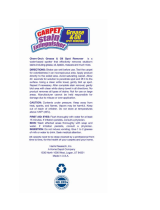
3.0
SPILL AND SPOT CLEANING
EFFECTIVE SPOT REMOVAL STARTS WITH
THE PROPER PRODUCT SPECIFICATION
If you specify one of Mohawk’s stain resistant ber systems
you are specifying the best stain resistant systems available.
These products allow 96% of all spills to be removed with
water only, ensuring that your carpet will last longer, look
new longer, be less expensive and more environmentally
friendly to maintain.
SPOT CLEANING IS ESSENTIAL
Dry soil often hides within the carpet pile, but spots and
spills can stand out, depending upon the carpet’s color and
pattern. Therefore, to keep your carpet looking as good as
possible it’s essential that spot cleaning become an impor-
tant part of your maintenance program. Since most carpet
manufactured today has mill-applied stain blockers and
soil-resist treatments, your chances for success with spot
cleaning are greatly improved if you act quickly and use the
proper products, tools and techniques.
TAKE IMMEDIATE ACTION
Spot cleaning is often regarded as a cumbersome chore
and very often the same large equipment used to perform
deep cleanings of a large areas ends up being used to clean
spots that should be attended to sooner. Don’t delay clean-
ing spots until your regularly scheduled cleaning. The best
time to treat a spot is when you see it, and a simple way
to extract it is by blotting it with a plain, white absorbent
towel. If your cleaning staff has towels at their disposal,
they can quickly blot up as much of a fresh spill as possible.
If the spot has dried, blot it with a towel that has been
damp- ened with plain water or a general-purpose spotter.
This is a great rst step to get as much of the contaminant
out of the carpet as possible, and it can remove many com-
mon water- borne spots. If a residue remains, a spot extrac-
tor can be used at a more appropriate time and the spot will
disappear with much less effort.
Another simple but effective option for spot cleaning is
through the use of an absorbent compound. This method,
often called dry extraction, uses an absorbent material that
is applied to the affected area. The compound absorbs and
dislodges the soil and is then easily vacuumed away. This
cleaning method has the advantage of no drying time since
little water is used.
























